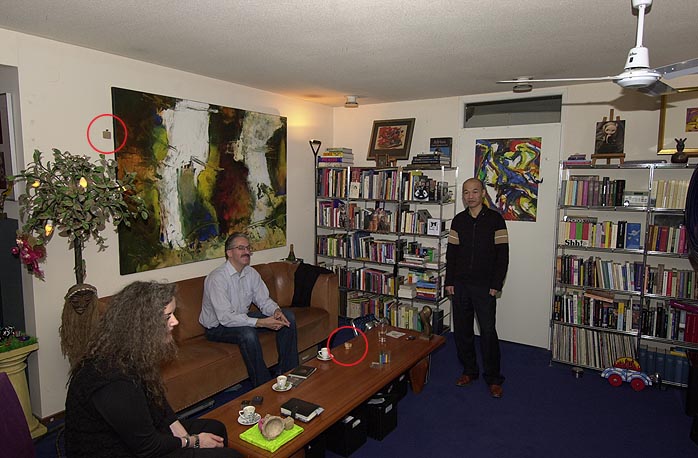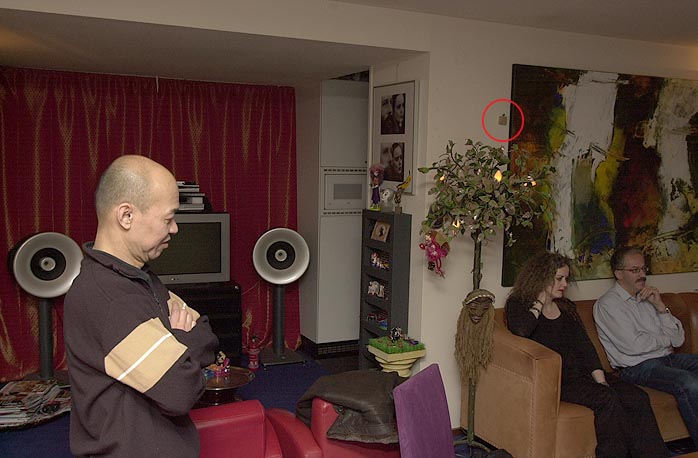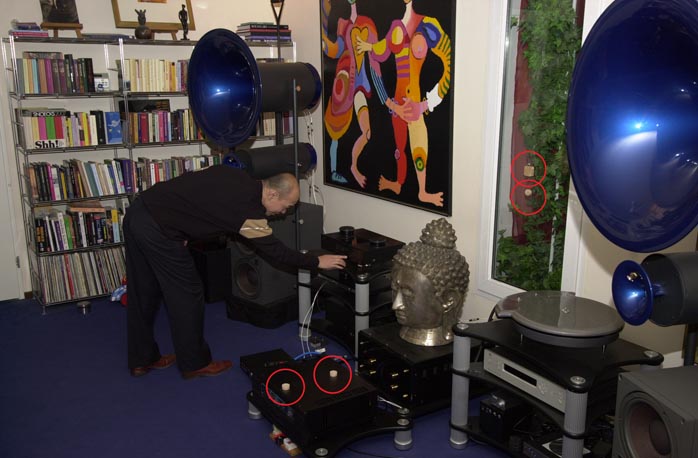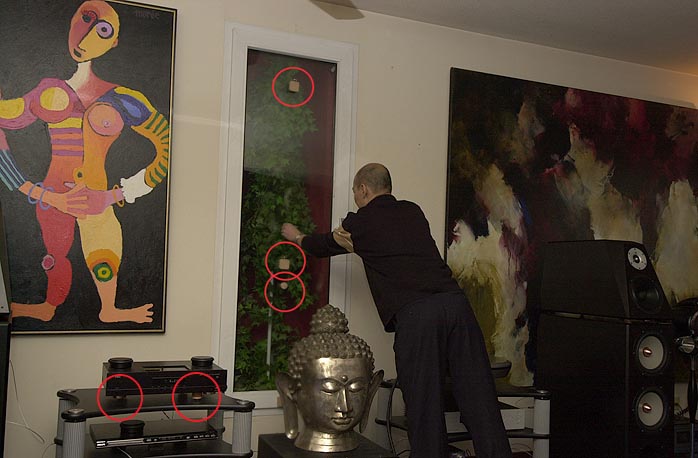|
|
|
|
|
This review page is supported in part by the sponsor whose ad is displayed above
|
|
 |
|
Franck in our house
The day before the workshops took place, Franck Tchang arrived via Amsterdam airport in Rotterdam. He insisted upon fine-tuning not only our listening room but our entire flat from the last time we met in Paris. As all rooms are connected via the air -- the medium we listen to -- treating the whole house becomes necessary for ultimate results. Curious as we are and already completely happy with the effects of the resonators we'd positioned in the listening room ourselves, Franck's offer proved impossible to resist of course.
After taking off his coat, our visitor immediately started to walk around the room. He noticed the streetcars 330 feet down from our inner city high rise and the wind pushing hard against it from the south-west. "Compression" was the first thing he said - compression. With our large glass bay catching not only a lot of street noises, it is oriented exactly along this south-west axis where 95% of the time, hard winds blow from.
|
|
 |
|
|
|
We first had to play a special recording for Franck. From his case he picked a familiar-looking CD. It was the second release of the Hadouk Trio - Live at Fip. Why Franck chose this remarkable CD is simple. Not only has the recording a very powerful frequency spectrum with extreme lows and vivid highs, the recording venue is a radio studio Franck knows by heart. He's played in it quite often himself.
Favorite tracks of his for tuning purposes are 5 and 6. The first track was cued up and Franck started to walk the room. With a serious look on his face, it was almost as though he entered a different state and went deeply into analytic mode. After listening that way to both tracks, he had formulated his plan of attack. From his case he took a small packet with tiny wooden blocks. With a little sticky goo, he now started to put one of these half-centimeter cubic Indian rosewood blocks on the window panes of the glass bay. Each window received one miniature block, all at different places. The effect was almost instantaneous. The vibrations of the windows and thus the build-up of outside pressure leaking into the room were transformed. Streetcars were of course still visible but now remote and silent. Living close to an ambulance station and in the middle of a big city, sirens are very common for us. Now their sounds were coming from far, far away, no longer as intimate and distracting as before. Six tiny blocks on 6 windows produced such an effect. Incroyable.
Next Franck picked up a couple of his diffusers. Acoustic System diffusers are wooden discs, somewhat like two checker stones glued together with a seal in the middle. In fact they are hollow and have a hole on top to act as small Helmholz resonators. Franck stuck a few of them in places where connecting surfaces are prone to resonance. A shelf supporting the CD player that already sat on a threesome of Franck's feet. Another diffuser under the coffee table and two more at the backs of the Avantgarde Duo subwoofers. Only days later did we discover a rogue one under the dining table in the glass bay. Tricky devil, that Tchang.
|
|
 |
|
Then Franck left the room and came back in. He had put a diffuser in the hallway on a closet door. After a short listen from the sweet spot, two more rosewood blocks found their way behind and exactly between the loudspeakers on the front wall. Our kitchen is of the open variety and starts in the listening/living room. Acoustically, the kitchen is a sort of pipe connected to the listening area. For this reason and to control the bass, Franck placed a tenth resonator, a basic, at the far end of the kitchen close to the floor.
|
|
 |
|
But the strangest -- and for the likes of James Randi & Co. most nonsensical -- places to put a resonator was still to come. Franck asked where the refrigerator was. He placed a resonator inside on the bottom ledge. [I see you've got all the important food groups covered - Tamari and bubbly. Most excellent. - Ed.] It took a few minutes and then the sound of the refrigerator was gone. No more buzzing. But another effect of the little resonator inside the closed fridge kicked in later. Thinking about air as the medium we breathe and listen to. The air inside a fridge is cold and thus has a different pressure potential. Cold air sinks to the bottom because it's heavier and denser. It appears that we notice the extra pressure emanating from the fridge. Call us crazy, all you naysayers, but until you experience it, keep your comments to yourselves.
|
|
 |
|
|
As his final statement, Franck positioned a wooden square block looking like a multi-layered resonator base. For now he was happy and ready for a little food. For us the system -- room, apartment -- were very different. The most striking one was in the bass. It's taken us a long time to get the Avantgarde subs dialed in the way we like. Still -- and more specifically after the upgrade to Omega status which transforms the two horns each to 107dB sensitivity at 17 ohms -- the bass was lagging behind. In the far recesses of our brains and wallets, we were dreaming of a pair of new Avantgarde subs like the Mezzo models enjoy - bigger and faster.
With Franck's work and only minutes after he finished, he'd saved us quite the long Euro green. The room was no longer fighting the woofers. There was now space to let the pressures vent to freely. Or in Franck's words, "no more compression". Bass sounded faster, more accurate and controlled. Even with electronic EQ, it's never before sounded this taut and realistic.
|
|
 |
|
|
Over dinner Franck revealed that he was not yet 100% satisfied. He had never heard a system like ours with its high dynamics and well-matched components. There were still things he could do that would result in even better performance. The hallway needed some extra attention. Tomorrow after the workshop, he'd finish up our room.
|
|
 |
|
|
After the workshop, we took Franck back to our place again. He immediately went to the end of the hallway and placed a similar wooden block as he put behind the equipment - a sandwiched 5" x 5" maple block. Again we listened to the Hadouk Trio and Franck went on his now usual rounds through the room and flat. He noticed some final metallic ringing. "Where did that come from," he asked several times. Then he found the source of this annoyance. One of the drawers of our office-type CD storage cabinets was not filled completely. So Franck took a diffuser and placed it in the drawer, killing the metallic rattle rather adequately.
|
|
 |
|
|
This concluded Franck's tuning of our dwelling but not our adventures of meeting the wizard of resonance tuning. When we had dinner together after wrapping up the flat with a bow, he pulled out a secret emergency resonator from his pocket and put it right in the middle of our restaurant table. He asked us to listen carefully for what was going to happen. The Indonesian restaurant was very busy on this Saturday night. Many families and friends were enjoying the sumptuous delights of the rijsttafel, huge collections of various rice, vegetable, meat and side dishes. All these happy eaters made quite the din. After a few minutes however, the three of us were as though enveloped in our own private bubble. Our own voices had gotten somewhat damped and lacking in spatial information but sounds from outside the bubble were subdued and much farther away. Putting the silver resonator upside down on the tablecloth to stop it working brought all the background noise back again. We repeated this uncovering and covering several times, each time with the same results. Franck insisted we carry a resonator on us every time we go to a concert or restaurant. By turning the resonator and so changing The Window as Franck had already demonstrated in the workshop, one can focus on the stage at a concert or, in a restaurant, choose a victim to eavesdrop on.
After taking Franck back to his hotel after a wonderful -- and thanks to the resonator quiet -- meal, we went home and listened for hours deep into the night. Saturday nights in Rotterdam are never quiet. Cruising is popular down the avenue and public transportation goes on into the wee hours, good for constant noise pollution - at least until our Parisian acoustician came by. Even at very low playback volumes, the sound was full, tight and so very involving. Bass now completely matched the mids and highs.
|
|
 |
|
We have to be fair. The amount of resonators we have installed is way beyond standard - if there is anything like a standard in this magic. As Srajan reported from his Hong Kong visit, two or four resonators will do a great job already. Linnman stated that he maxes out at about $5000 worth of resonators when he tweaks the rooms of friends. We are lucky to enjoy the full Monty, the ne plus ultra of what these resonators and diffusers can do to a home. We are very happy to be the guinea pigs for this.
Besides the resonators in the listening room, kitchen and hallway, we have put a few professional resonators to work as well. The difference between professional and domestic resonators is the base. Where home audio resonators use a large wooden block with a tripod as cup base, the professional resonator attaches a fixed pin to the cup that then sits in a small hardwood block. These professional resonators are used in more extreme environments where a cup loosely resting in a tripod might dislodge.
|
|
|
There is a professional resonator in the fridge and we use one inside amplifiers. As the pictures show, a small resonator sits between the tubes of our Audio Note Meishu and the Moscode 401HR. To cancel turbulences, we've also tried professional resonators inside the Avantgarde Duo horns. Having a resonator inside a tube amp tightens the bass but not the way a tube damper does. A tube damper in the form of a ring or collar also kills the microphonics of a tube and with that its 'tubiness'. A resonator just kills the air pressure (compression) around the tubes and thus cleans things up. Inside the horn of an Avantgarde, it works the same as in a vent pipe of a bass reflex loudspeaker. It cancels turbulences in the pressurized air flow.
|
|
 |
|
 |
|
|
|
 |
|
With all these positive effects and our profound satisfaction with the results, the big question naturally remains. How the eff do these things work? One side of our brains doesn't give a damn. Of all things in life, science does not begin to touch a fraction of how and why things work. Why bother. The other side of our inquisitive brains just had to go ask Franck. For that, we made another appointment, this time at Franck's home turf in Paris. If we needed another excuse to visit Paris, Franck offered to tune our car as well!
Driving 500km to Paris in an untuned car and back the same route in a tuned car looked like a great 'scientific' experiment to us. And since we had to return some loudspeakers to their manufacturer near Paris, we could kill two birds with one stone as the Yanks say.
|
|
 |
|
Maneuvering through the City of Lights with the help of a GPS navigation system is great fun. We met Franck looking for a parking spot and went with him to his favorite tabac for morning coffee where he began to explain his vision on the workings of the resonators.
In electricity there is current and voltage. With the resonators, Franck talks of pressure and tension. The trick behind the resonator is to convert pressure to tension. With the electrical variant, it depends on the resistor you use for current to voltage conversion. The resistor has a resistance, a damping factor. This damping factor is derived from the materials used inside the resistor. The same goes for a resonator. The materials -- copper, silver or gold alloys and pure platinum -- dictate the damping factor. In a room the air pressure -- higher than average at the spots where the resonators are deployed -- is caught between a block and a bowl. The tension inside the bowl is specific to the material and once excited by the air pressure, will emit its own oscillation.
|
|
|
 |
|
As a musician who has built his own guitars, Franck gave a more palpable example. Take a bass. That's a large body with some taut strings and a bridge. You excite the strings that are under tension, the energy is transmitted to the body of the bass via the bridge. Now the wooden body starts to vibrate -- resonate -- and that excites the air around it. The other way around as in the case of the resonators, the body resonates due to air pressure from another source and the strings will start to resonate as well. An unstretched string won't produce sounds, however. It needs to be under tension to introduce the necessary damping factor.
Regarding the conversion process, the first pressure wave hitting the resonator is out of control at that location. The resonator breaks up the pressure there and counters with its own pressure wave based on the material used. This secondary wave is then picked up by the listener as if emitting from a unique source, albeit at a lower energy level than the original wave would have been. The resonator tidies up acoustic clutter in pressure zones like corners and other boundaries. But you cannot use just one type of resonator throughout. You need different materials with their own specific damping factors.
|
|
|
 |
|
Why a resonator works in a restaurant is because the large pressure and air agitation of surrounding noises sets our internal defense system on alert. By adding a sympathetic counter pressure, we swap primary sources and psychologically cancel out the offending din.
After this explanation, we went over to Franck's studio to listen to some music. When Robin Ford was playing, Franck could not resist and played along. And how! Since our last visit, one of his turntables had grown a new Schroeder arm. One of his latest projects, a new set of loudspeakers, was not yet ready as Franck was awaiting the drivers. We saw the design renderings which suggest that the speakers must be very special. CES 2007 might see their first public appearance if the maestro is happy with their evolution by then.
Then we had to go to our car where Franck wanted to perform some tricks under the hood. With the experiences of tuning a few other cars in Singapore, he placed four professional resonators on the engine and wheel cases and two others in the cabin. Then we went for a test drive. Upon starting up the engine, the five year-old van was much quieter. No more noises even from cold start-up. Driving too proved that a lot of background noise was now attenuated and converted. We had to finally say goodbye to our host and make our way back to our fully tuned residence. Do we need to add that the way home, even though it was through really stormy weather, was far more comfortable and far less tiresome than on the way in? Paris indeed is a great city to visit. Especially when you know just whom to visit... |
|
|
 |
|
|
|
 |
|
 |
|
|
|
|
|
|
|
|
|
|